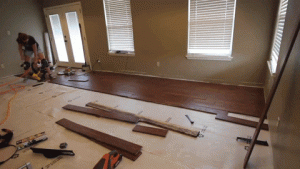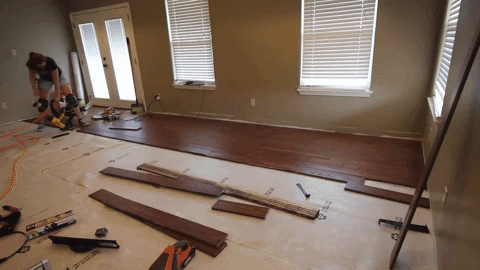
Hardwood flooring, a timeless and elegant choice, adds warmth, character, and value to any home. However, navigating the world of hardwood can be daunting for beginners. This detailed article aims to demystify the process, providing a comprehensive understanding of the essential basics.
I. The Core Components: Understanding Hardwood Flooring Types
- Solid Hardwood: The Authentic Classic:
- Crafted from single planks of solid wood, solid hardwood offers a timeless aesthetic and a sense of natural authenticity.
- Its thickness allows for multiple sanding and refinishing cycles, extending its lifespan for decades.
- However, solid hardwood is highly susceptible to moisture and humidity fluctuations, leading to potential warping, cupping, or gapping.
- This limits its suitability to stable, above-grade environments with controlled humidity.
- Engineered Hardwood: The Versatile Alternative:
- Engineered hardwood consists of multiple layers of wood veneers bonded together, with a top layer (wear layer) of real hardwood.
- Its layered construction provides enhanced dimensional stability, making it more resistant to moisture and humidity changes.
- This versatility allows for installation in a wider range of environments, including basements and some areas with moderate humidity.
- The thickness of the wear layer will determine how many times the floor can be refinished.
II. The Natural Palette: Exploring Wood Species and Characteristics
- The Rich Diversity of Species:
- Each wood species possesses unique characteristics, including grain patterns, color variations, and hardness.
- Understanding these differences is crucial for selecting a species that aligns with your aesthetic preferences and lifestyle.
- Key Domestic Species:
- Oak (Red & White): Durable, versatile, and readily available, with distinct grain patterns.
- Maple: Light-colored, smooth, and modern, with a subtle grain.
- Hickory: Exceptionally hard and rustic, with dramatic grain variations.
- Walnut: Dark, rich, and elegant, with a fine, beautiful grain.
- Cherry: Warm, reddish-brown, and elegant, darkening with age.
- Ash: Light colored, strong, and flexible.
- The Janka Hardness Scale:
- This scale quantifies a wood’s resistance to denting and wear, providing a valuable tool for assessing durability.
- Higher Janka ratings indicate harder, more resilient woods, suitable for high-traffic areas.
- Wood Stability:
- Some wood species react more to changes in humidity than others.
III. The Finishing Touches: Grades and Finishes Demystified
- Lumber Grades: A Quality Spectrum:
- Hardwood lumber is graded based on the number and size of defects, such as knots and color variations.
- Higher grades offer a more uniform and aesthetically pleasing appearance, while lower grades may exhibit more character.
- The Spectrum of Finishes:
- Finishes protect the wood and influence its appearance and durability.
- Common finishes include:
- Polyurethane: A durable, synthetic finish available in various sheen levels.
- Oil Finishes: Penetrate the wood, enhancing its natural beauty and providing a matte finish.
- Wax Finishes: Offer a natural look but require regular maintenance.
- Aluminum Oxide: A very durable factory applied finish.
- Sheen levels (matte, satin, semi-gloss, gloss) influence the floor’s overall appearance.
IV. The Craft of Installation: Mastering the Techniques
- Subfloor Preparation: The Foundation of Success:
- A level, clean, and dry subfloor is essential for a successful installation.
- Learn how to assess and prepare different subfloor types (plywood, concrete).
- Moisture barriers are very important for proper installation.
- Installation Methods: A Comparative Analysis:
- Explore the various installation methods, including nailing, stapling, gluing, and floating.
- Understand the advantages and disadvantages of each method.
- Professional installation is highly recommended.
- The Acclimation Imperative:
- Master the concept of acclimation and its crucial role in preventing dimensional changes.
- Learn how to properly acclimate hardwood flooring to the installation environment.
V. The Maintenance Mandate: Preserving Your Investment
- Cleaning and Care: The Foundation of Longevity:
- Learn proper cleaning techniques and the use of appropriate cleaning products.
- Understand the importance of preventing excessive moisture and scratches.
- Refinishing: A Restoration Art:
- Explore the process of sanding and refinishing hardwood floors.
- Understand the limitations of refinishing engineered hardwood.
- Humidity Control: A Vital Factor:
- Learn how to control humidity levels to prevent damage to hardwood floors.
VI. Key Considerations and Best Practices:
- Environmental Factors: Consider the room’s moisture levels, sunlight exposure, and traffic patterns.
- Budgetary Planning: Factor in material, installation, and maintenance costs.
- Sustainability: Consider sustainable sourcing options and certifications like FSC.
- Professional Help: Seek professional help when needed.
By understanding these hardwood flooring basics, homeowners can make informed decisions and create beautiful, lasting floors that enhance their home’s value and style.
